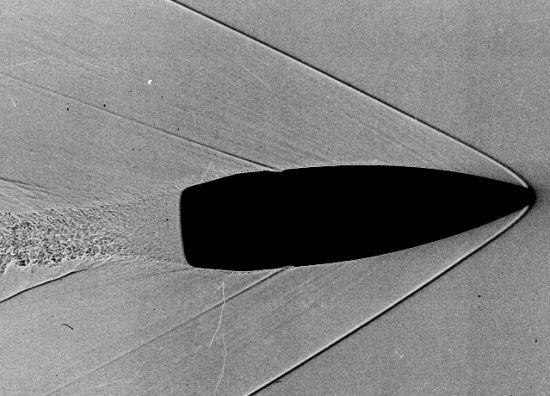Tomorrow there will be a 30% chance of rain with the possibility of scattered thundershowers which might spread from the southern Free State to the Mpumalanga Lowveld. Talk about keeping your options open! Well predicting bullet performance on an animal that you are hunting can be pretty much like predicting the weather. There are just so many variables involved.
Take a look at Figure 1. These .223 bullets (apart from the unused one on the far right which is shown for the purposes of comparison), were all recovered from the same species of animal shot by the same ranger on the same day at approximately (give or take 30m) the same range – but just look how differently they have performed! What is going on here?
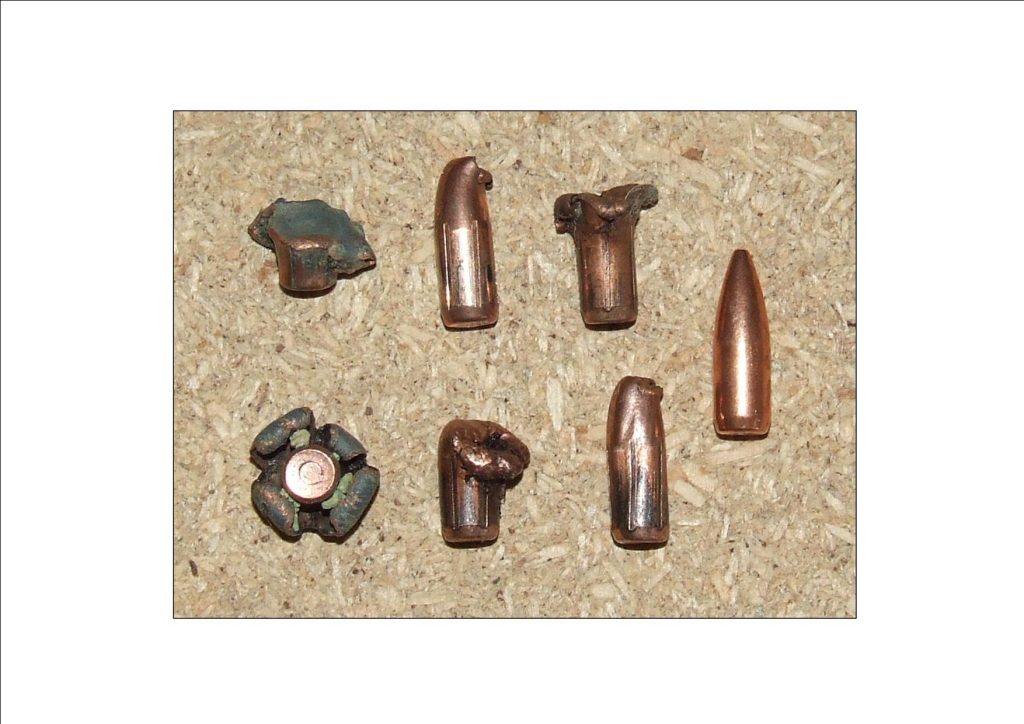
We here enter the rather unpredictable realm of terminal ballistics where many of our expectations on how a bullet will perform seem to dissipate into one big question mark.
A bullet’s flight path from the moment it leaves the muzzle until just before it impacts with a target animal, assuming its flight path is not interrupted by a twig or other unexpected object, is reasonably predictable. With some experimentation, the marksman will know how much the bullet he is shooting will drop at different ranges and how much it will be steered off course by a crosswind.
The shape of the bullets profile (ballistic coefficient) and its mass will be the main determinants influencing how it will fly through the air as it is subjected to the onrushing air stream and the downward pull of gravity. Height above sea level (air pressure), ambient temperature and humidity can be factored into the equation and still make the impact point on the target reasonably predictable.
The moment the bullet impacts the target, however, is the point where confusion sets in and hunters are often caught unawares as the expected effect of their chosen bullet fails to materialize resulting in either the animal running off, or in the case of dangerous big game charging when it (whatever “it” might be) was supposed to fall down dead in its tracks!
What is this variable that is often not well understood by the average hunter? Before we can begin to answer this question we should first clarify what is supposed to happen when a bullet impacts living tissue.
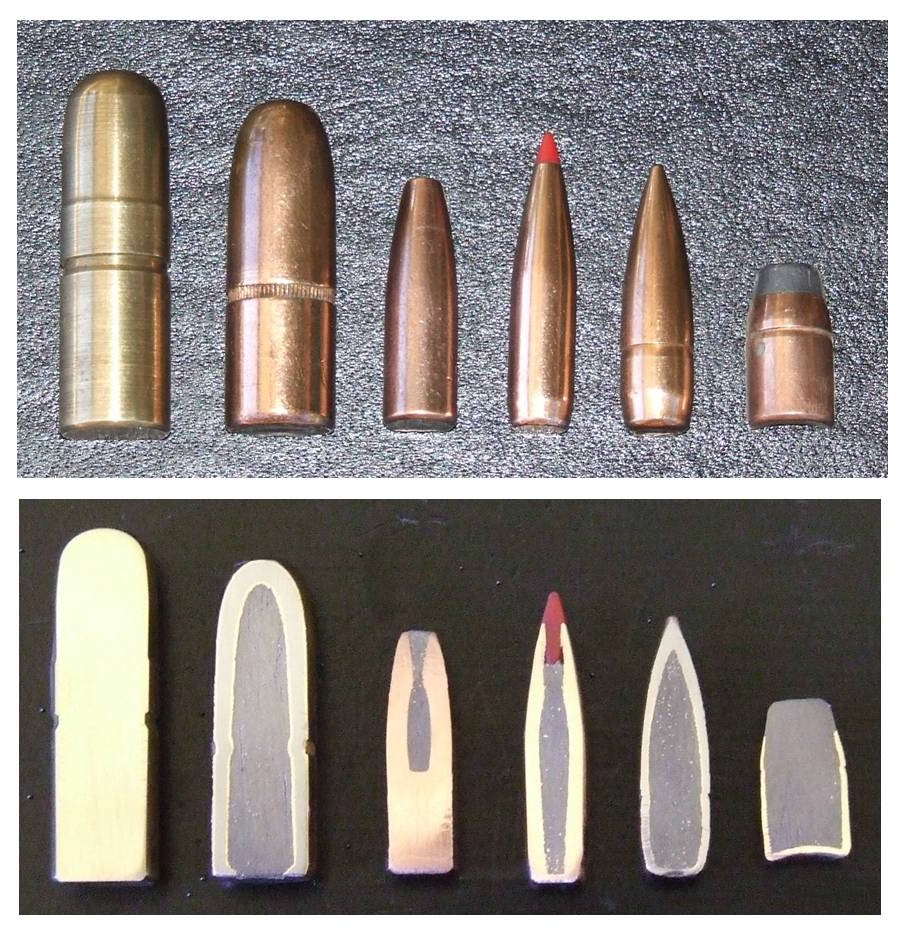
Refer if you will to Figure 2. Here you will see a variety of bullet types and designs. They differ significantly from one another in shape, mass, and construction but all have one thing in common. As hunting bullets, they were designed to kill animals as effectively as possible.
Each bullet was however designed for a specific application. In other words, they were designed to be used on a specific group of animals. Whereas there are differences in construction with some having exposed lead alloy tips, others having a copper alloy full metal jacket, polymer plastic tips, spitzer (pointed), round-nosed, hot core bonded, partitioned or whatever, they can be basically divided into two groups – expanding and non-expanding bullet types.
The behaviour of any bullet, once it hits and then enters into the tissues of a living animal, is determined by four factors:
- The construction of the bullet
- Its impact velocity
- Shape
- The path that the bullet follows through the target animal.
Bullet construction is one of the most important factors influencing penetration. Here we can identify two main animal types that ballistic engineers have in mind when they design bullets for hunting them. The first group is relatively thin-skinned with a light to medium bone structure and the second comprises animals with thick, tough skin, large muscle mass, and heavy bone structure protecting vital organs such as the brain, heart, and lungs.
Bullets designed for the first group are usually of the expanding type consisting of an outer gilded copper layer enclosing a metal alloy (usually lead and antimony) having its tip exposed or having a polymer plastic tip. Some are also designed with a hollow point. See Figure 3 for typical examples.
The design features of these bullets allow for the bullet to peel back on itself on making contact with and passing through animal tissue.
This is referred to as “mushrooming” and the reason for designing it to work in this way is to increase the size of the wound channel so that more damage is done and the animal will die as quickly as possible. See Figure 4.
Now some bullets are specifically designed not to mushroom but to enter and pass through animal tissue with little or no expansion. The bullet is designed for penetration into vital areas that might be protected by tough skin, muscle, and bone. When a bullet expands it loses energy and begins slowing up because the wider diameter of the expanded bullet has a greater frontal surface area and experiences greater resistance to forward travel.
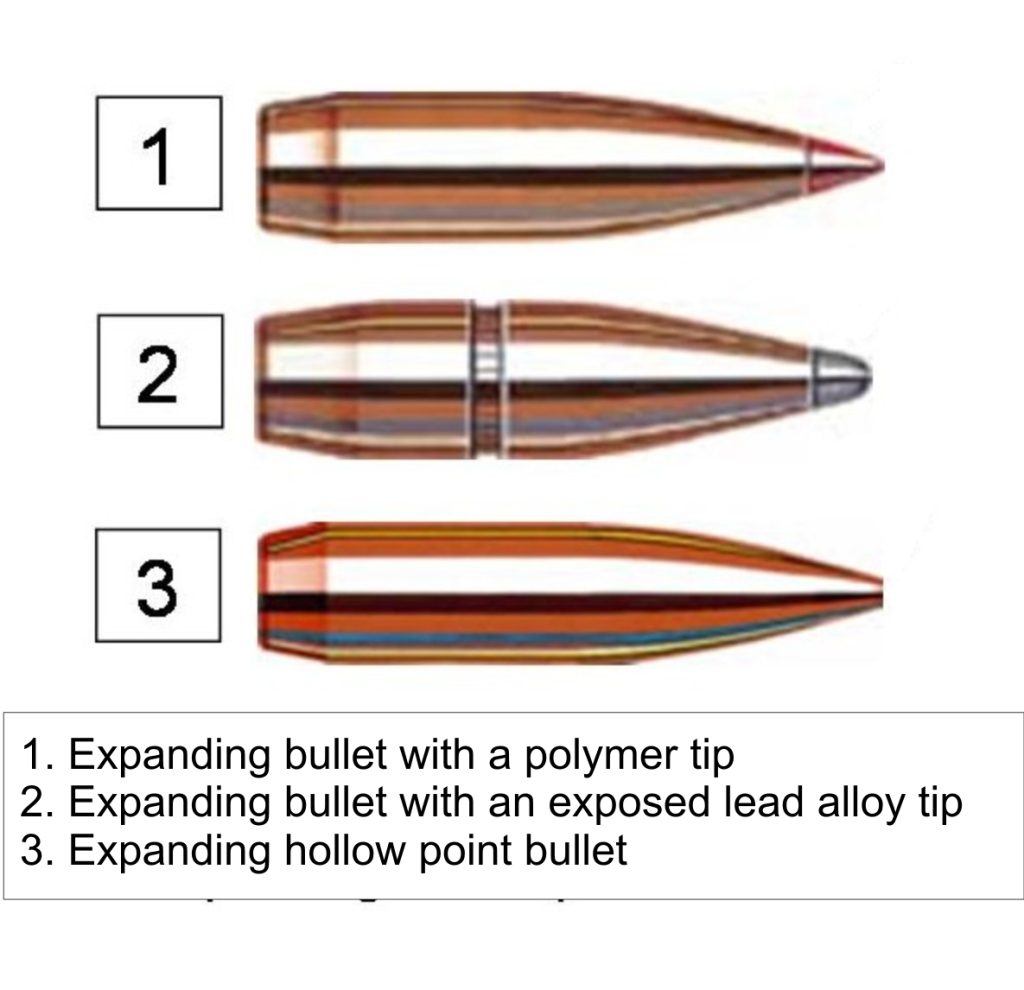
Hence an expanded bullet will have less penetration than a solid non-expanding bullet and might not be able to reach the vitals and may even break up or fragment on hitting solid, dense material like bone. These solids may consist of solid brass or a core of heavy lead alloy completely surrounded with a jacket of copper allow. Bullets like these are intended for big dangerous game such as elephant, rhino, hippo and buffalo and examples are shown in Figure 5.
The impact velocity will also have an effect on penetration. Too slow and the bullet is going nowhere. Too fast and the bullet will disintegrate on impact causing a shallow “cratering wound”. Impact velocity determines the hydrodynamic pressure and the effects on bullet deformation. But, over and above this it also determines the amount of cavitation in tissue (creating a temporary and permanent cavity) which is proportional to its kinetic energy.
The greater the cavitation the less the penetration.

The shape of a bullet will have an influence on how it passes through animal tissue. Spitzer bullets which do not deform become unstable at normal hunting bullet velocities and will not penetrate as far as round or flat-nosed bullets fired at the same velocity. Non-deforming round-nosed bullets, in turn, will generally have better penetration than flat-nosed bullets but this depends on the width of the flat nose and the radius of the round nose. Most rifle hunting bullets today are of a pointed shape and are designed to expand but the amount of penetration based on shape also applies to them as well.
Now the foregoing might be pretty “ho-hum” we know it all, to all the ballistic aficionados out there but it brings us back to our original question. Why do identical bullets, shot into the same type of animal at approximately the same range behave differently?
Now all things being equal – the same type of bullet, hitting the same type of animal at the same impact velocity at the same range, one would expect all the bullets to behave in the same manner and have the same effect on the animal and therefore be predictable. But they don’t and they often behave in the most unexpected way. Look at Figure 1 again. Of the six bullets, two have mushroomed perfectly (this was what most would have predicted based on their knowledge of the bullet’s design), two have partially mushroomed, and two have hardly mushroomed at all!
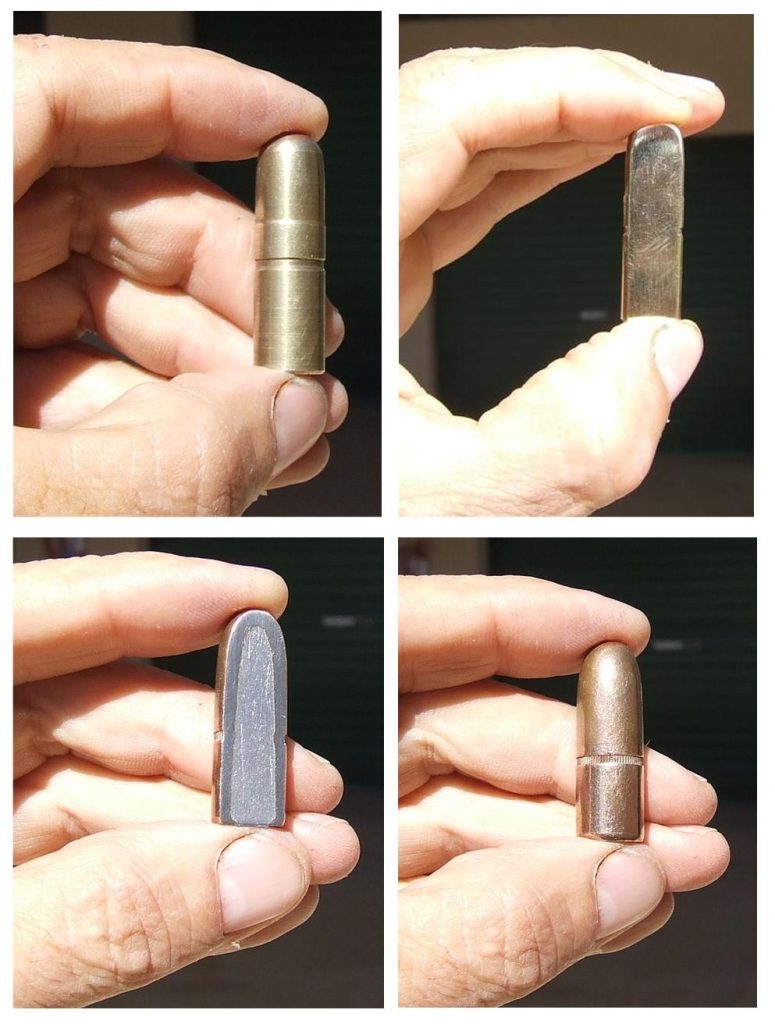
All the variables we mentioned earlier on which affect bullet performance are equal barring the one which hunters often neglect to consider when they predict how their bullet of choice is going to perform on the animal they are shooting at. By a process of elimination, you should by now have figured out that the final arbiter of a bullet’s performance which can negate all the others, is the line or path that a bullet travels from its point of entry to its point of exit or to the point where it finally comes to rest within the body of an animal.
Bullet performance is most often tested on materials such as ballistic gelatin, or wet phone books and this gives rise to certain expectations. Valuable information is gained from these tests. It has been shown for example in tests using a variety of bullets at different velocities that increasing velocity (within a range of 1600 – 3200 feet per second) has a tendency to decrease penetration.
The problem with these tests is that the material used to measure bullet performance is homogenous and this can lead to expectations that might not necessarily work out in reality because animals are not homogenous. Ballistic gelatin might closely approximate muscle tissue but is very different to horn, bone, tendons, and gas-filled organs such as lungs or fragile blood-filled organs such as the liver, kidneys or spleen.
A bullet shot into an animal can follow very different paths through materials of very different density and strength. Bullets of any given construction and impact velocity may have significant differences in performance depending on the part of the animal struck and the shotline through the target. Let us now look at some case scenarios to illustrate the point. Refer please if you will to Figure 6.
| Figure 6: Examples of shotlines through a buffalo |
Let us set up a hypothetical case scenario. It is 30 years ago and a hunter is using a .375 H&H Magnum to hunt Cape buffalo. He has decided on a Winchester 300 grain Silvertip bullet traveling at 2600 feet per second to dispatch the animal with. Assuming shots 1, 2, 4, and 5 were taken from different angles but were all aimed at the heart-lung area, shot 3 was intended as a neck (spinal) shot and shot 6 was an abdominal shot that the hunter took as the animal was running away.
Now at this point we are not discussing the merits or demerits of the different shots. We are investigating the possible way in which the bullets could perform and how the animal would respond given the different shotlines.
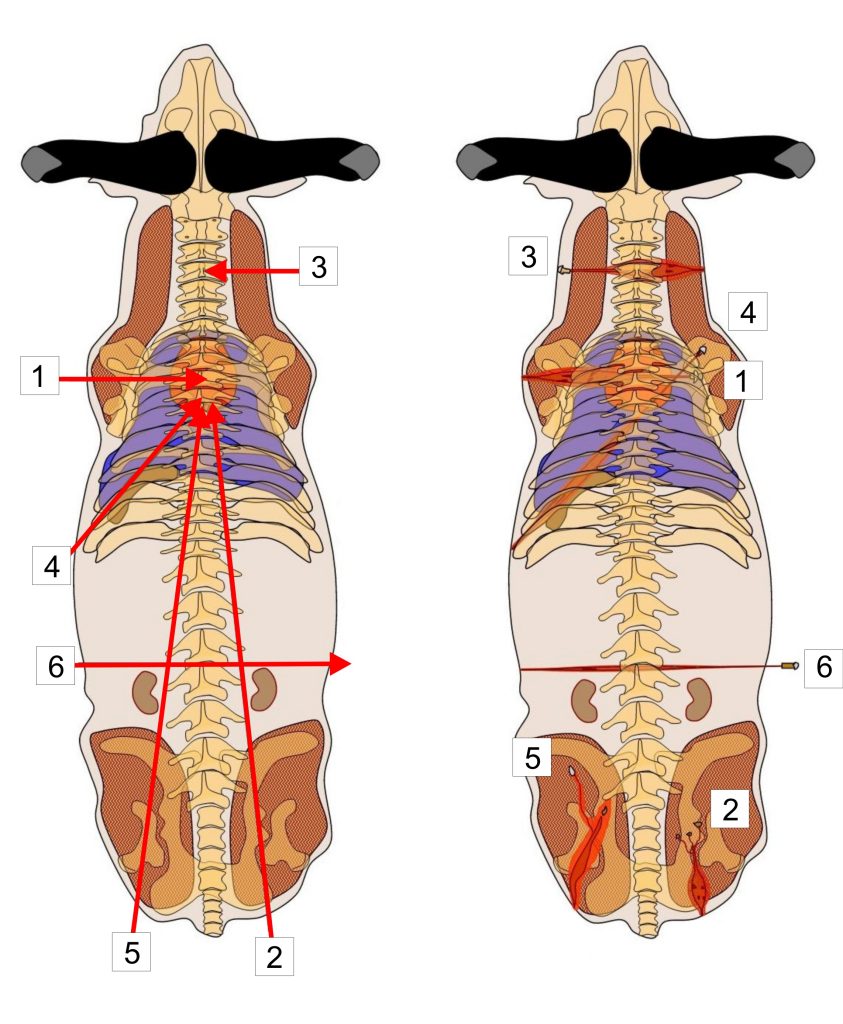

Shot 1
A side on presentation in which the hunter aims for the heart with a shot placed through the shoulder.
Path of bullet travel: The bullet forces its way through a layer of tough skin, connective tissue and thick muscle. It penetrates well and begins mushrooming. Now it encounters the top end of the humerus which in the case of buffalo is a rather substantial bone. The bullet expands fully but, because of the increased resistance, it slows significantly. It punches through the bone and through the soft pleura (membrane) lining the thoracic cavity.
It now enters soft, air filled lung tissue and passes easily through before hitting the heart itself, composed of strong muscle. The bullet is fully expanded and the kinetic energy is dropping off quickly but enough energy remains to drive the bullet through the right lung before finally coming to rest against the bones of the opposite shoulder.
Condition of bullet: Fully expanded (mushroomed) and mostly intact. Moderate weight retention.
Effect on and response from an animal: A temporary cavity was momentarily created and a permanent cavity remained behind in the bone, lungs and heart tissue. Severe bleeding resulted, the lungs collapsed and the damaged heart stopped beating. However, enough oxygen remains in the blood of the mortally wounded buffalo to live for up to three minutes. It might drag the fractured leg and run off with pink frothy blood spewing from the nostrils or, if it sees the hunter, and is that way inclined may charge and cause some damage or even death to the hunter before it finally expires. There was a clear blood trail to follow of bright arterial blood.
Shot 2
The hunter approaches the buffalo from slightly behind and attempts a shot high up through the hind leg angling towards the heart/lung area.
Path of bullet travel: The bullet travels through tough skin and thick gluteus muscle and begins to expand. It then hits the very thick and hard pelvic bone and fragments in a number of pieces each of which travels a short way before coming to rest in the pelvic or abdominal cavity. No vital organ has been reached.
Condition of bullet: The bullet has broken up into several pieces and failed to penetrate far beyond the pelvis.
Effect on and response from an animal: No vital organ has been damaged. The permanent cavity is short and not well developed as the bullet broke up and the pieces formed small but rather insignificant wound channels. Blood loss is not significant (assuming no major blood vessel has been hit). If the pelvis is badly broken the animal might not be able to run but may still pull itself forward by using its front legs. If the pelvis is only fractured or not badly broken the buffalo may run off (or charge). If it runs off it will have to be tracked until another shot (hopefully a fatal one) can be taken.
There will probably be a very insignificant blood trail to follow (unless by chance a major blood vessel has been hit). If the buffalo gets away and cannot be found it could over time recover but may be crippled or if the wound is of such a nature that severe infection sets in may die a slow, painful and lingering death (especially if the bullet has lodged in the abdomen and peritonitis sets in).
Shot 3
From a side on presentation, the hunter places a shot about one-third way down in the neck, aiming for the cervical vertebrae.
Path of bullet travel: The bullet passes through the thick and tough neck skin and then on through the powerful neck muscles. It then breaks into and through the strong cervical vertebrae deforming somewhat and losing some of the mushroom petals but pushing on through the opposite neck muscles rapidly losing energy before finally coming to rest just under the skin on the far side.
Condition of bullet: It has mushroomed well but some of the mushroom petals have broken off and remained behind in the vertebra. Weight retention is fair.
Effect on and response from animal: The animal was immediately incapacitated as the spinal cord was severed. It fell immediately to the ground and made no attempt to rise. There was still some movement in the face and ears for a minute or two before the animal died.
Shot 4
Here the hunter takes a quartering away shot from the left side angling the shot forward to hit the heart and or lungs.
Path of bullet travel: The bullet penetrated the flank skin, a relatively thin layer of abdominal muscle and angling forward perforated the liver, the lungs, and the heart finally coming to rest against the inside of the humerus fracturing but not penetrating it.
Condition of bullet: The bullet did not encounter any hard material (i.e. bone) during its travel from entry to exiting the right-hand lung. By which time much of its energy had dissipated due to the long distance of travel. It mushroomed predictably and by the time it hit the inside of the humerus had enough energy to crack the bone but not penetrate it.
The bullet mushroomed well, retained most of its weight, held up well when it hit the leg bone and was pretty much intact on recovery.
Effect on and response from an animal: The animal responded by running off (or charging the hunter) but will die soon of oxygen starvation of the brain as blood pours from the heart, liver, and lungs (all of which have been severely damaged). There will in all likelihood be a good arterial blood trail to follow. It may run for a couple of hundred meters before slowing and finally collapsing to the ground as it sounds the mournful death bellow characteristic of these magnificent beasts.
Shot 5
A similar shot as shot 2 but lower.
Path of bullet travel: The bullet penetrated the rump skin and traveled a short way through thick thigh muscle before hitting the femur – a thick and very tough bone. It shattered the bone dissipating most of its energy in doing so. The impact also caused the bullet jacket and core to separate each traveling for a short distance before coming to rest in the pelvic cavity.
Condition of bullet: Weight retention very poor as the internal core and the copper jacket keeping the bullet together have separated resulting in very poor penetration.
Effect on and response from an animal: Perhaps (if the hunter is lucky) the large femoral artery might be severed which can cause the buffalo to bleed to death fairly quickly (there will be a good blood trail). If not there will be no significant blood trail to follow up and even with a broken leg the buffalo may run off and lie in wait for the unwary hunter daring to follow up.
If the wounded animal cannot be tracked down it may survive but be crippled and in pain or if severe infection sets in eventually die after having suffered severe pain and discomfort.
Shot 6
From a side-on shot presentation, the animal gets a fright and jumps forward a moment before the shot goes off. The bullet hits far back in the abdomen passing well below the spine.
Path of bullet travel: The bullet enters the skin and passes through a thin layer of muscle then through thin gut walls with their watery content again encounters a thin layer of muscle and exits the skin on the far side. During its passage through the buffalo, the bullet has encountered little tough tissue and no hard bone.
Condition of bullet: The bullet has only mushroomed to about a third of its capacity but has about 98% weight retention.
Effect on and response from an animal: A small wound channel (permanent cavity) has resulted in little bleeding and no vital organ or major blood vessel damaged. The buffalo ran off looking a little hunched up or may charge the hunter if he is spotted. The wound which has ruptured gut walls will cause abdominal contents to spill into the abdominal cavity and cause peritonitis which is generally fatal after a time and will cause the animal to die a lingering and painful death if it cannot be found.
Summary
Well, what have we learned by this little exercise? The same bullet fired at the same animal, at the same velocity, and at the same range can behave very differently. The behaviour of the bullet will ultimately be determined by and large by the shotline through the animal.
It is difficult to predict bullet performance in the real world but we can better do so if we know where to place our shots and if we know something about the anatomy of the animal we are hunting.
But be prepared, even then, for the unexpected.

